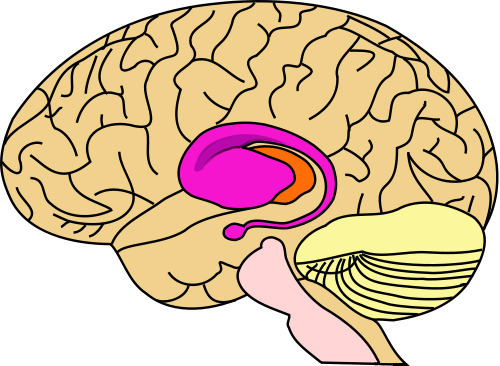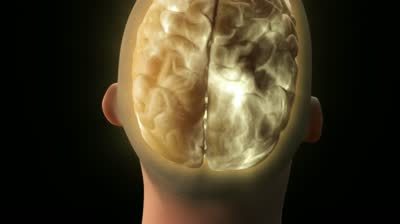
(Image caption: Inside the basal ganglia (highlighted in pink), neurons compete for the brain’s decisions. New research indicates this mechanism favors “no” as our default response. Credit: Wikimedia Commons)
A new computational model based on data from rodent brains shows that “Go” and “No-Go” signals compete in the brain, originating from the nerve cells in the striatum – a part of brain that plays a crucial role in decision making, learning and various motor functions. But, the deck is stacked against the Go neurons, which are expressed in D1 type dopamine receptors, says Arvind Kumar the senior author of the study and a researcher at the Department of Computational Biology at KTH Royal Institute of Technology.
“It could be that humans are wired to be natural naysayers,” Kumar says. The reason is that the D1 (Go) neurons and their rival D2 (No Go) neurons are projected in pathways within the striatum that inhibit each other. “However, it turns out that the No-Go pathway exerts more inhibition on the Go pathway than vice versa,” he says.
“This inherent bias creates the decision transition threshold for the kind of input that is likely to change your preference,” Kumar says. “One way to adjust the threshold is through learning. Another way is with neuromodulators like dopamine.”
The bias in this threshold is due to an asymmetrical connection between the two circuits of neurons, in which the No Go pathway is stronger. Therefore, D1 neurons require slightly higher input. However, with this setting, D1 neurons can overcome the No Go pathway only when they receive weak inputs from the cerebral cortex that generates functions such as sensory perception, motor command, conscious thought and language. The switch between Go or No-Go decisions, depending on cortical input, gives rise to the decision transition threshold.
“This threshold where you are likely to switch your decision from Go to No Go, is created by unequal connectivity. If the connectivity were identical then such a threshold would not arise.” says Jyotika Bahuguna, the lead author of the study and a joint PhD student at KTH and Bernstein Center Freiburg, Germany.
Kumar says the model, which he developed and tested with colleagues at the Bernstein Center Freiburg, at the University of Freiburg, Germany, sheds new light on cognitive problems associated with basal ganglia dysfunction, such as Parkinson’s disease and Tourette’s syndrome.

No comments:
Post a Comment